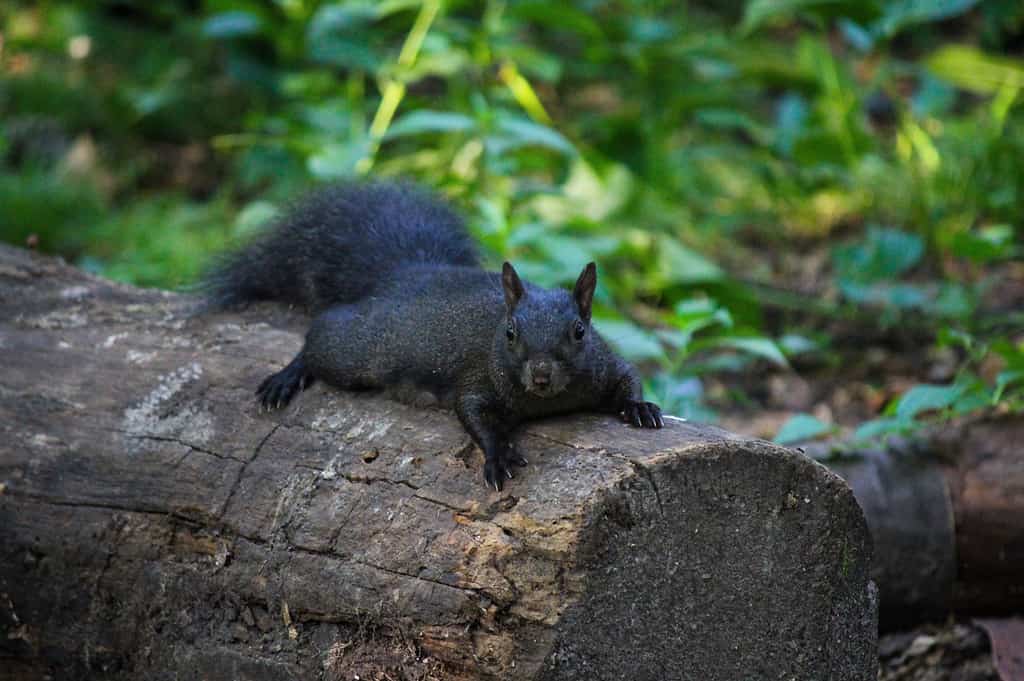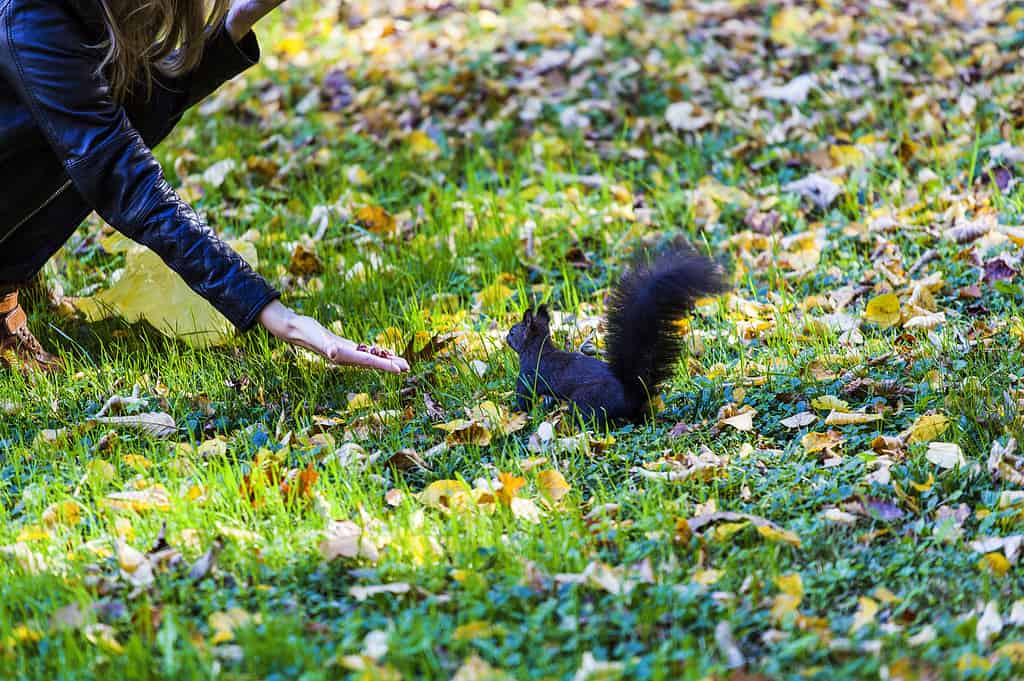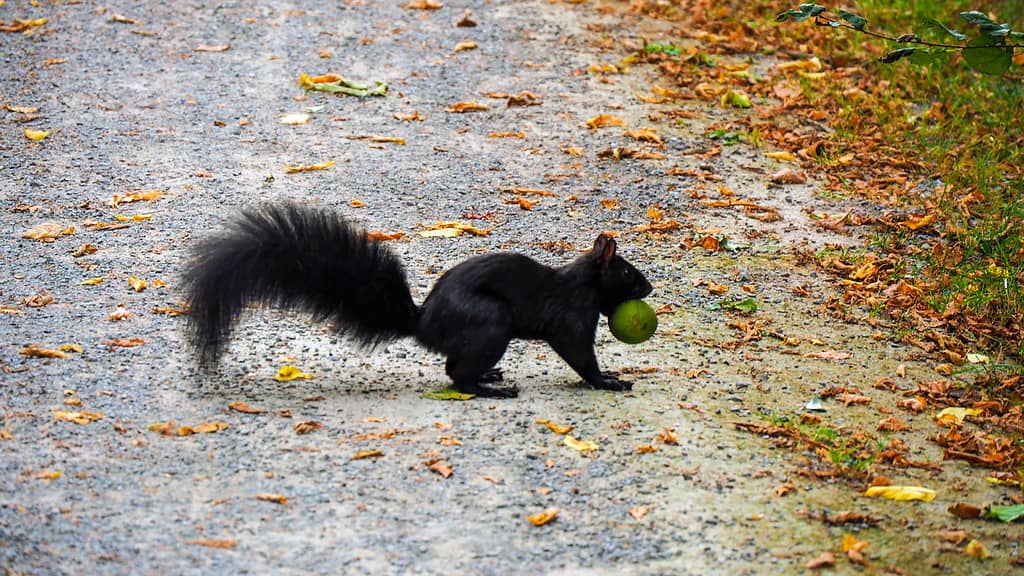Tree squirrels and ground squirrels are common throughout the world. For the most part, common squirrels appear brown, gray, tan, and even red. However, some other color variants exist, like black squirrels. Learn what causes black squirrels and find out how rare it is for them to appear. Also, find out where they can be found in the world today!
What Are Black Squirrels?

Most black squirrels in the U.S. are members of the eastern gray squirrel species.
©iStock.com/Helen Davies
Black squirrels are not an individual species like red squirrels or the eastern gray squirrel that is common throughout North America. Instead, black squirrels are members of various squirrel species. The only difference is that they have a hereditary abundance of melanin resulting in black morphs of existing species.
The effects of melanism merely change the color of the fur. The squirrel is still the same species. For example, most of the black squirrels seen in the U.S. belong to the species Sciurus carolinensis, the Eastern gray squirrel. The other species is Sciurus niger, the fox squirrel.
Knowing what these squirrels are, it’s important to wonder what causes black squirrels to exist. In other words, what prompted this melanism to occur?
How Did Black Squirrels Come to Be?

©C. Hamilton/Shutterstock.com
Scientists believe that the existence of black squirrels is caused by interspecies mating between fox squirrels and eastern gray squirrels. The two species have been observed engaging in mating pursuits and mating.
Scientists found that some fox squirrels carry defective pigment genes that make the species’ fur appear darker. Their fur appears black than presenting in the brown-gray or reddish-gray typically associated with the species. Still, most of the black squirrels around today are members of the eastern gray squirrel species, not the fox squirrel.
Scientists believe that male fox squirrels passed the defective pigment genes to their offspring through interspecies mating with gray eastern squirrels. At least, that was the result of a 2019 study. The scientists concluded that the presence of the MC1R∆24 allele and melanism in the eastern gray squirrels probably resulted from breeding with fox squirrels, but other possibilities exist as well.
Now that we know how these squirrels came to be, it’s fair to wonder whether their melanism has any benefits.
The Benefits of Melanism in Squirrels

©iStock.com/Photogirl
The story of how black squirrels came to be is not that exciting or mysterious. At least, the way scientists believe black squirrels came to be is not all that mysterious. Still, the black squirrels are very different from the other members of their species. As a result, they may get certain benefits that others do not. Consider some of the ways that black squirrels could benefit from their melanism.
Thermal Benefits
One of the most direct benefits of having black fur is that the coloration allows squirrels to absorb and retain more heat. While that could be troublesome in places where the summers are brutally hot, it’s highly beneficial in colder climates.
One study found that black fox squirrels were more likely to be active on cloudy winter mornings than orange members of their species. The reason was that the darker fur helped the squirrels retain a higher skin temperature, so they were more active.
Staying Hidden from Predators
Another potential benefit that squirrels get from black fur is concealment. The darker fur could make them more difficult to spot for predators. Not only can they blend into the dark woods where they live, but they may look different enough in the eyes of predators for them to be overlooked completely. More studies are needed on this potential impact, though.
Reduced Road Mortality
Millions of squirrels are killed by cars every year. Gray squirrels tend to blend in with all but freshly laid asphalt on the road. As a result, drivers have a harder time seeing them. Black squirrels stand out more, so drivers are more aware of their presence. As a result, some studies have found that fewer black squirrels end up as roadkill compared to gray morphs.
Knowing what causes black squirrels and the benefits they receive from their melanism, it’s time to consider where they’re found.
Where Do Black Squirrels Live?

©Vasily Gamayunov/Shutterstock.com
Black squirrels are found in the United States and Canada in North America as well as in parts of the United Kingdom. In North America, the black morph of the eastern gray squirrel is far more common in the northern reaches of the animal’s range. Thus, it’s more likely that a black eastern gray squirrel will be seen near the Great Lakes, in Canada, and the Northeast compared to the southern United States.
Meanwhile, black morphs of the fox squirrel are more often found in places in the southeastern United States. In both cases, the density of the black squirrels is greater in some areas than others, especially near urban areas.
The black squirrels in the United Kingdom were introduced to the country. However, the means through which that incursion happened is presently unknown.
How Rare Are Black Squirrels?

©iStock.com/Jennifer Seeman
Scientists estimate that less than one percent of squirrels are black squirrels. The oft-quoted number is that roughly one in 10,000 squirrels have black fur. That makes the morph of these animals very rare. However, they’re more common in some areas than others.
In some areas, black morphs of squirrel species are far more common. Nevertheless, the average number of black squirrels in most areas is far lower than the typical morphs of either species.
Having outlined what causes black squirrels and their rarity, it’s possible to wonder about the creatures’ future. Could these morphs continue to increase in population? Could they become the new normal in urban areas and places where they’re most common? New studies on these creatures are needed to find out precisely where they’ve come from and where they’re poised to go.
Is Seeing a Black Squirrel Considered Good Luck?

A Black Squirrel is seen as a sign of prosperity and good luck by many.
©blightylad-infocus/iStock via Getty Images
In Western cultures, black squirrels are not only signs of good luck but they are also thought of as positive symbols of change, fertility, and prosperity. For couples who are trying to conceive, crossing paths with this dark-colored squirrel can be a good sign. These mammals are quite frequently associated with spirituality and symbolism, and due to their dark color, they are often thought of as mysterious and magical.
Each culture has a different interpretation of seeing these squirrels, and a few beliefs and cultures may not always be positive, with some believing they have black fur due to their ties to the occult. However, they are generally seen as harbingers of prosperity and good luck, as well as a sign of good things to come.
The photo featured at the top of this post is © Gill_figueroa/Shutterstock.com
Thank you for reading! Have some feedback for us? Contact the AZ Animals editorial team.






